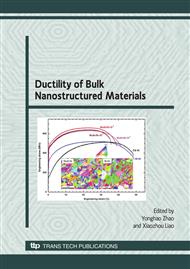p.197
p.205
p.211
p.223
p.231
p.249
p.263
p.273
p.303
The Analysis of SPD Paradox by Computer Modeling Technique
Abstract:
The paper has viewed the manifestation of the paradox of severe plastic deformation (SPD), caused by the occurrence of preexisting deformation twins in ultrafine-grained Cu, which has been obtained by the combination of the SPD method, accomplished by an equal-channel angular pressing with the conventional methods of deformation-thermal treatment. The high strength of the obtained samples has proved to be conditioned by the occurrence of the high density of the coherent twin boundaries, serving as effective obstacles on the way of slipping dislocations. Moreover, the occurrence of the twins creates favorable conditions for the dislocation density increase both in the grains with the twins and in the grains without them. As a result the sample hardens, contributing additionally into its strength. Simultaneously it manifests high ductility. By doing so the deformation behavior of the sample is mainly conditioned by the grain boundaries of grains free from the twins. The results were obtained on the basis of the dislocation-based model which develops models of Y. Estrin and L. Tóth, M. Zehetbauer, and L. Remy.
Info:
Periodical:
Pages:
231-248
Citation:
Online since:
November 2009
Authors:
Price:
Сopyright:
© 2010 Trans Tech Publications Ltd. All Rights Reserved
Share:
Citation:


